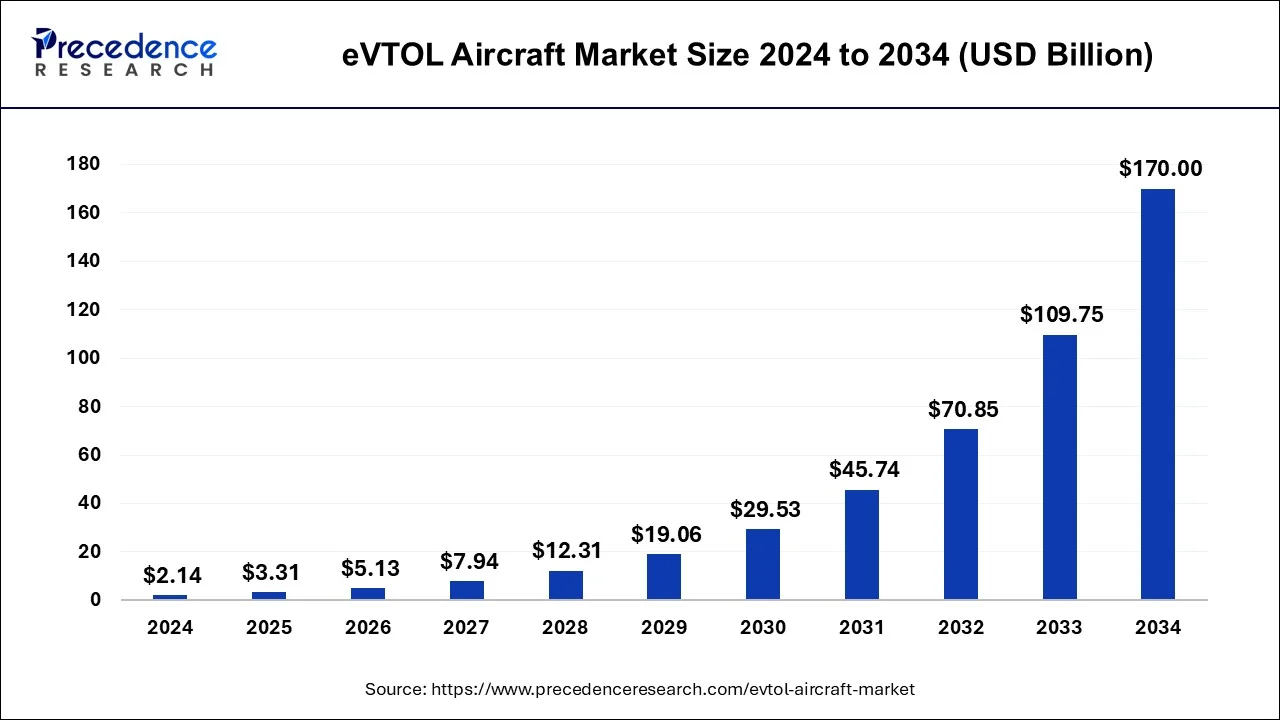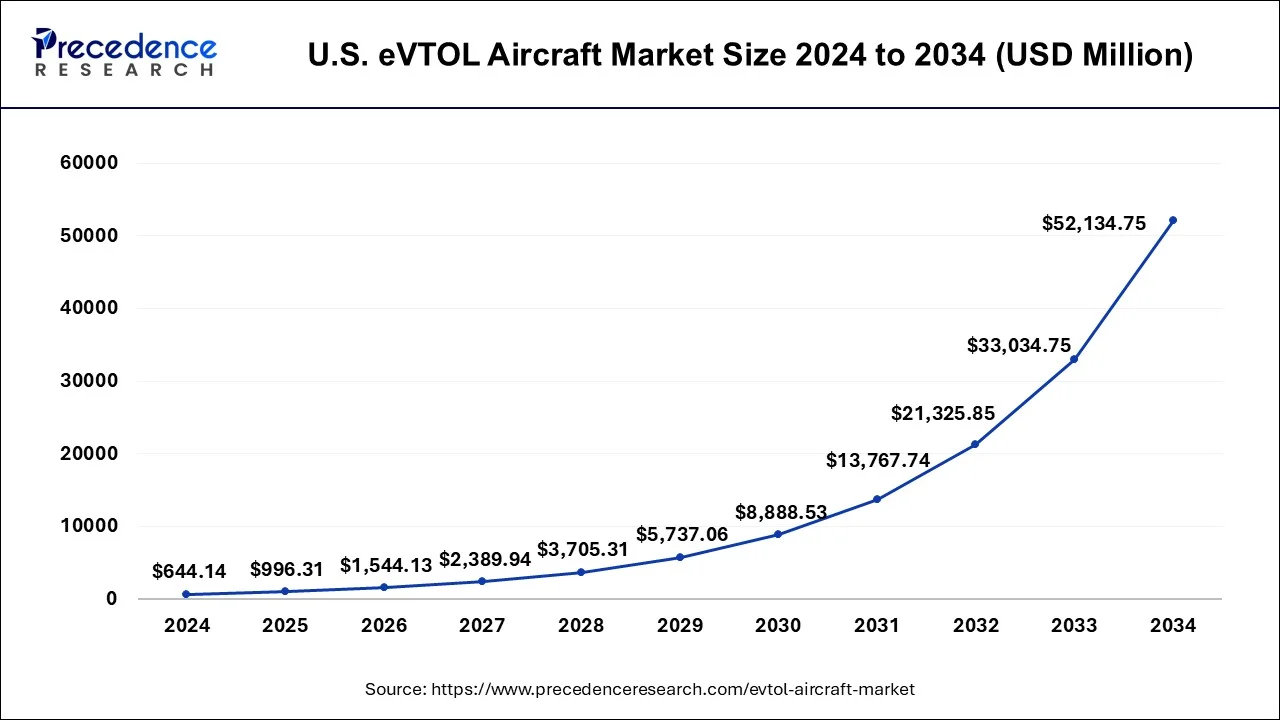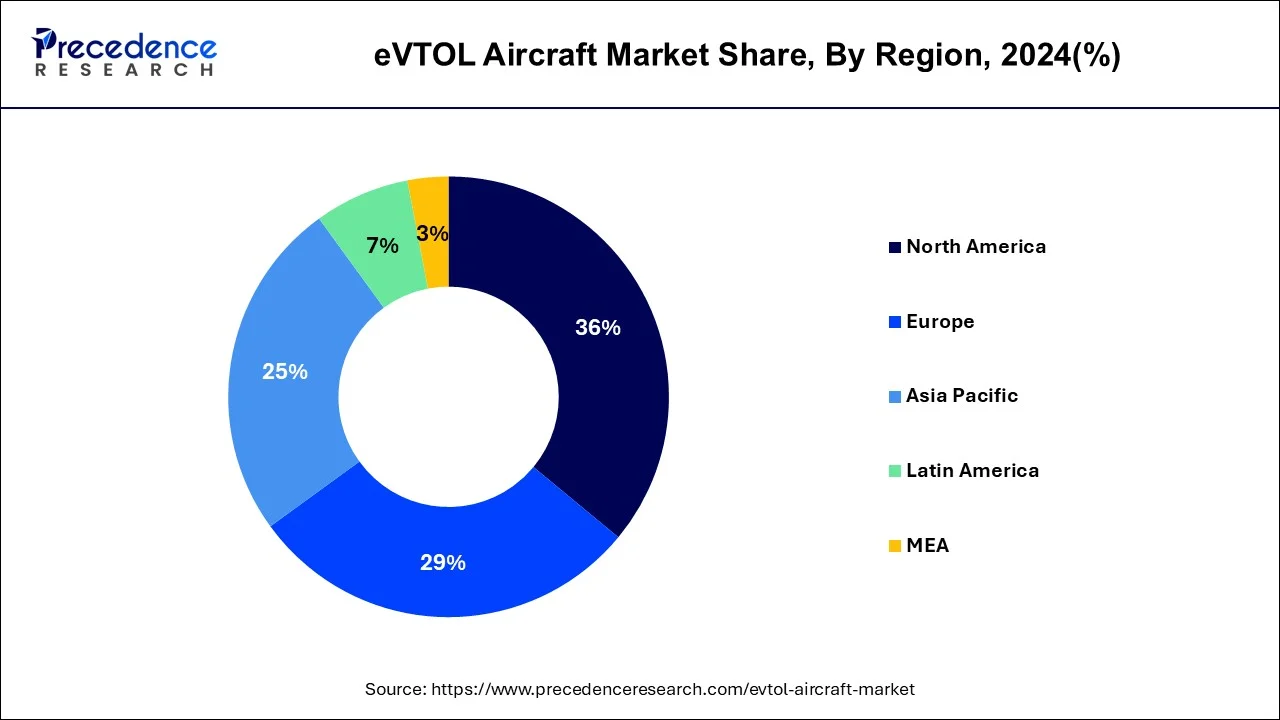eVTOL Aircraft Market Size and Forecast 2025 to 2034
The global eVTOL aircraft market size was USD 2.14 billion in 2024, grew to USD 2.14 billion in 2025 and is projected to surpass around USD 170 billion by 2034, representing a healthy CAGR of 54.90% between 2024 and 2034. The deployment of air mobility urban aircraft will likely drive the growth of the global market for eVTOL aircraft.

eVTOL Aircraft Market Key Takeaways
- By lift technology, the vectored thrust segment holds the largest revenue share and will likely maintain growth from 2025 to 2034.
- By mode of operation, the piloted segment generated more than 31% revenue share in 2024 and the semi-autonomous segment dominates the market and captured more than 38% revenue share.
- By propulsion type, the battery-electric segment is showing significant growth.
- By range, the 200-500 km segment will likely dominate the market from 2025-2034.
- By application, the commercial segment is considered the quickest-growing segment.
- By maximum take-off weight (MTOW), The <250 kg segment will likely grow at a good CAGR rate.
- By geography, North America dominates the market.
U.S. eVTOL Aircraft Market Size and Growth 2024 to 2034
The U.S. eVTOL aircraft market size accounted for USD 644.14 million in 2024 and is predicted to reach around USD 52134.75 million by 2034, expanding at a CAGR of 55.17% between 2025 and 2034.

North America dominates the market geographically due to its rapid adoption of eVTOL aircraft for urban air mobility. With increased spending on research and development (R&D) activities in the aviation field, the market will likey maintain growth during the forecast period. The technological advancement and investment in the research sector of eVTOL aircraft are primary driving factors for the ill likegrowth of the market for eVTOL aircraft in Europe. The presence of major key players such as Volocopter GmbH and Lilium has contributed to the market growth in Germany. Asia Pacific will likely show significant growth in the eVTOL aircraft market due to the region's expansion of aviation services. China and Japan a re thelargest contributors to the growth of the market for eVTOL aircraft in the Asia Pacific.

Embraer, Azul, and Flapper contribute to the growth of the market for eVTOL aircraft in Latin America. Collaboration and strategic partnerships by major key players in the region will likely boost the market for Latin America during the forecast period of 2025-2034. Owing to the rise in startups related to VTOL aircraft, the market for eVTOL aircraft is anticipated to grow in the Middle East and Africa.
Market Overview
An electric vertical takeoff and landing (eVTOL) aircraft is electrically powered and offers efficient and faster services. An eVTOL aircraft is considered a next-generation travel solution due to the safety and multi-facet benefits. A few other advantages of eVTOL aircraft are they reduce the trip timing, provide safe trips in remote areas, and are extremely environment friendly which helps in the reduction of carbon emissions. Electrical vertical takeoff and landing aircraft are used for transportation, medical services, agricultural activities, rescue missions, logistics, and national security. Electronic technologies are transforming at a pace that has shown significant growth in the global market for eVTOL aircraft. Generally, aircraft need a runway to take off or land; an exception to such aircraft, electric VTOL is designed to take off and land vertically without a long run away.
Multiple motors manufacture eVTOL aircraft that ensure safety and enhance aircraft efficiency. In the global aviation sector, the invention of electric vertical takeoff and landing aircraft is considered an independent technological solution for transportation needs. The increasing need for modern transportation methods and noise-free aircraft will accelerate the global demand for advanced eVTOL aircraft.
Market Scope
| Report Coverage | Details |
| Market Size in 2024 | USD 2.14 Billion |
| Market Size by 2034 | USD 170 Billion |
| Growth Rate from 2025 to 2034 | CAGR of 54.90% |
| Base Year | 2024 |
| Forecast Period | 2025 to 2034 |
| Largest Market | North America |
| Fastest Growing Market | Europe |
| Segments Covered | By Lift Technology, By Mode of Operation, By Propulsion Type, By Range, By Application, and By Maximum Take-Off Weight (MTOW) |
| Regions Covered | North America, Europe, Asia-Pacific, Latin America and Middle East & Africa |
Market Dynamics
Companies such as Honda, SpaceX, AirBus, and NASA are focused on developing technologically advanced eVTOL aircraft, which will fuel the growth of the global market for eVTOL aircraft during the forecast period of 2023-2032. Several market companies focus on developing eVTOL aircraft that produce less carbon emission and support green energy. Retail and logistic industries focus more on drone delivery services to reduce shipping timing. Retail and logistic industries are the fastest-growing contributors to the revenue share in the global market for eVTOL aircraft.
The market's overall growth is due to the increasing need for quick-flying aircraft services. Rising collaboration, strategic partnerships, and investments from other sectors into the eVTOL sector for developing and manufacturing eVTOL aircraft are considered major drivers for the growth of the global market for eVTOL aircraft. For instance, in January 2020, Toyota invested in Joby Aviation, and the invested amount was approximately $400 million. Growing urban population demands solutions for smarter transportation. Modern solutions such as air mobility, air taxis, and other quick yet cheap methods will likely drive the market during the forecast period.
Safety concerns associated with eVTOL aircraft services will likely hamper the market's growth. Slow public acceptance of eVTOL aircraft services is a major restraining factor for the global market growth for eVTOL aircraft. Moreover, strict regulations for the approvals of eVTOL aircraft hamper the market growth.
Lift Technology Insight
Based on the technology for lift, the global market for eVTOL aircraft includes multirotor, vectored thrust, & lift plus cruise. The vectored thrust section accounts for the largest revenue share and will likely maintain growth during the forecast period. Vectored thrust technology provides better endurance to the aircraft to enhance efficacy during the performance.
High-performance capabilities associated with the segment have led to its growth in recent years. Moreover, multirotor technology is considered the fastest-growing segment. Multirotor technology is used for aerial photography and surveillance. The segment is experiencing growth due to increasing demand for delivery applications.
Mode of Operation Insight
Based on the mode of operation, the global market for eVTOL aircraft is segmented into piloted, autonomous & semi-autonomous. The piloted segment will likely boost in the forecast period due to increased demand from the emergency medical service sector. In 2024 the piloted segment generated more than 31% revenue share and the semi-autonomous segment dominates the market and captured more than 38% revenue share.
Due to the rapid adaptation of artificial intelligence (AI) technology in the manufacturing of eVTOL aircraft, the autonomous mode of operation segment is considered the fastest-growing one. However, the semi-autonomous segment shows steady growth in the global market for eVTOL aircraft.
Propulsion Type Insight
Based on propulsion type, the global market for eVTOL aircraft includes hybrid-electric, battery-electric, & hydrogen-electric. With the increasing demand for fully electric aircraft in the market, the battery-electric segment is showing significant growth. The segment will likely maintain growth during the forecast period. Another factor for the segment to grow at a promising CAGR is battery-electric aircraft reduce the operation cost and carbon footprint.
On the other hand, hydrogen fuel cells offer better and more large storage facilities, which makes the hydrogen-electric segment the second fastest-growing segment of the global market for eVTOL aircraft. In comparison, hybrid-electric technology is widely used in long-range aircraft.
Range Insight
Based on Range, the global market for eVTOL aircraft includes two segments, 0-200 Km & 200-500 Km. 200-500 km Range segment will likely dominate the global market for eVTOL aircraft during the forecast period of 2025-2034, the rising demand for long-range electric vertical takeoff and landing (eVTOL) aircraft. Long-range eVTOL aircraft are generally used in intercity transport. Increasing demand for eVTOL aircraft from the commercial sector for delivery services will likely show significant growth for the 0-200km range segment in the upcoming years.
Application Insight
Based on application, the global market for eVTOL aircraft consists of military, commercial & emergency medical services (EMS). The Covid-19 pandemic boosted the demand for air ambulances to provide infected people with better and faster healthcare services. Benefits associated with air ambulance services are likely to boost the emergency medical service (EMS) segment. The emergency medical services (EMS) segment includes air ambulance and medical cargo transport services. The eVTOL aircraft used in the emergency medical service (EMS) segment is fully equipped, staffed, and modified to respond to emergency medical conditions. Generally, eVTOL aircraft are used in transporting critical patients from remote areas or areas facing natural/manmade disasters.
The commercial segment is considered the fastest-growing segment of the global market for eVTOL aircraft, with the rapid adoption of air delivery services by air taxis and drones in urban areas. For instance, in November 2022, Amazon revealed that the company is launching a new generation drone delivery drone ‘MK30' in 2026. This delivery drone has an expanded delivery range, a smaller, lighter design with safety-critical features.
Maximum Take-off Weight (MTOW) Insight
Based on MTOW, the global market for eVTOL aircraft consists <250 kg, 250-500 kg, 500-1000 kg, 1000-1500 kg &>1500kg. The <250 kg segment will likely grow at a good CAGR rate owing to the rise in demand for lightweight and small eVOTL aircraft for delivery services in urban areas. Furthermore, the increasing demand for passenger travel and cargo transportation will likely boost the 500-1000 kg segment during the forecast period. The >1500 kg segment will experience growth with rising demand for eVOTL aircraft in military applications.
eVTOL Aircraft Market Companies
- Airbus SE
- Bell Textron, Inc.
- EHang Holdings Ltd.
- Elbit Systems) Ltd.
- Embraer SA
- Kitty Hawk
- Joby Aviation
- Beta Technologies
Recent Developments
- In December 2022, a leading developer of electric vertical takeoff and landing aircraft, AIR, announced that its flagship e-VTOL AIR ONE aircraft had completed its first full transition flight.
- In December 2022, Volare, private aircraft management, and the charter group agreed to add up to 20 aircraft of Lilium Jet eVTOL to its fleet in the UK.
- In December 2022, a developer of all-electric aircraft for commercial passenger services, Joby Aviation, announced the completion of its second system review required by the Federal Aviation Administration (FAA) as part of the company's aircraft certification program.
- In October 2022, Eve Air Mobility announced that the company had entered a strategic partnership with FlyBlade India for eVTOL pilot project in India. The partnership aims to develop the urban air mobility ecosystem in India.
- In December 2022, Joby Aviation partnered with Aviation High School in New York to train aspiring aircraft technicians and leaders.
- In December 2022, a leading producer of electric vertical takeoff and landing (eVTOL) aircraft, Jaunt Air Mobility, signed a letter of intent with Vertiko Mobility from Quebec. The aim is to purchase 71 Jaunt Journey eVTOL aircraft.
- In November 2022, Lilium, a Munich, Germany-based leading developer of eVTOl aircraft, raised $119 million in its latest round of funding to help build jet eVTOL.
- In November 2022, an early leader in the market for eVTOL aircraft, Archer Aviation, based in the USA, announced that the company had started the production of its eVTOL called ‘Midnight.' The Midnight eVTOL is optimized for back-to-back 32 km trips, which carry a pilot with four passengers.
- In April 2021, United Parcel Service signed a contract with Beta Technologies. Under the contract, United Parcel Service will buy the aircraft 150 e-VTOL from Beta Technologies to start time-sensitive zero-emission deliveries.
Segments Covered in the Report
By Lift Technology
- Lift Plus Cruise
- Multirotor
- Vectored Thrust
By Mode of Operation
- Semi-Autonomous
- Autonomous
- Piloted
By Propulsion Type
- Hybrid-Electric
- Hydrogen-Electric
- Battery-Electric
By Range
- 200-500 Km
- 0-200 Km
By Application
- Emergency Medical Services (Ems)
- Medical Cargo Transport
- Air Ambulance
- Commercial
- Delivery Drones
- Air Taxi
- Military
- Combat Mission
- Cargo Transport
By Maximum Take-Off Weight (MTOW)
- <250 Kg
- 250-500 Kg
- 500-1000 Kg
- 1000-1500 Kg
- >1500kg
ByGeography
- North America
- Europe
- Asia-Pacific
- Latin America
- The Middle East and Africa
For inquiries regarding discounts, bulk purchases, or customization requests, please contact us at sales@precedenceresearch.com
Frequently Asked Questions
Ask For Sample
No cookie-cutter, only authentic analysis – take the 1st step to become a Precedence Research client
 sales@precedenceresearch.com
sales@precedenceresearch.com
 +1 804-441-9344
+1 804-441-9344